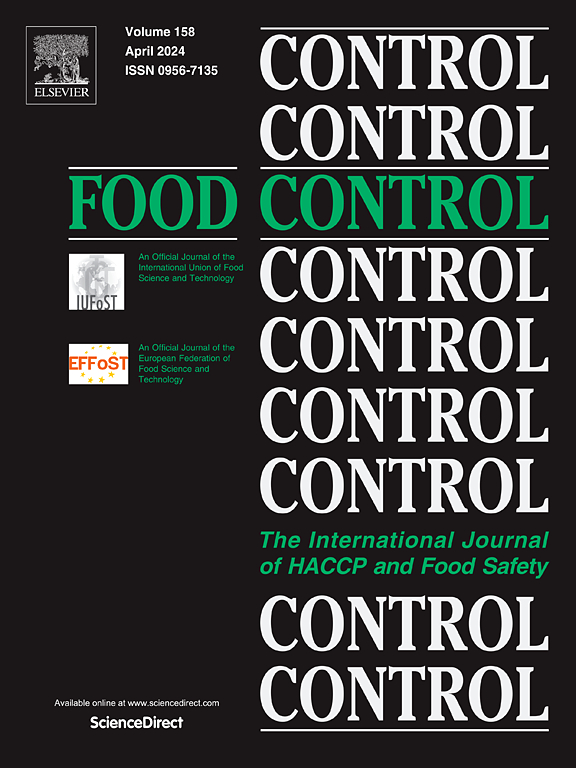Surveillance gap in seafood safety: Multidrug resistant Vibrio parahaemolyticus detected in shrimp imported to Norway
IF 6.3
1区 农林科学
Q1 FOOD SCIENCE & TECHNOLOGY
引用次数: 0
Abstract
Bacteria in the genus Vibrio are naturally found in marine and brackish waters and represent one of the main challenges to microbial seafood safety. However, no regulations currently address the threat posed by human pathogenic vibrios. This is of particular concern for seafood products imported from countries with high usage of antibacterial agents and frequent reporting of antibiotic resistant pathogens, including resistant vibrios. Viet Nam is one of the major providers of seafood exported to Norway, contributing with 137 tonnes of raw and frozen whiteleg shrimp (Litopenaeus vannamei) in 2021. Eight samples of whiteleg shrimp collected at Norwegian border control stations were examined for pathogenic Vibrio spp. Two of these samples tested positive for Vibrio parahaemolyticus, and the isolates were further subjected to antibiotic susceptibility testing and whole genome sequencing. The isolates, termed 556-1 and 1889-1, expressed phenotypic resistance and harboured resistance genes against clinically important antibiotics, including cephalosporins (blaCTX-M), trimethoprim (dfrA), sulphonamides (sul2), aminoglycosides (aph(3″)-Ib, aph(6)-Id, aac(3)-Iie) and amphenicols (catC). Furthermore, phenotypic resistance to legally applied antibiotics such as oxytetracycline and oxolinic acid, as well as antibiotics banned in Vietnamese aquaculture like enrofloxacin and ciprofloxacin, was also observed. Although the isolates did not harbour any of the main known virulence genes (tdh, trh), an overlapping pool of resistance genes has emerged in V. parahaemolyticus strains isolated from both clinical, shrimp, and environmental sources. The present work provides the first documentation of V.parahaemolyticus with acquired clinically relevant antibiotic resistance entering Norway through imported seafood. These findings highlight the need for a One Health approach to combat the global spread of multidrug resistant bacteria through the international food trade, by strengthening the surveillance and regulatory framework considering pathogenic Vibrio spp. in seafood.
海产品安全监测缺口:挪威进口虾中检出耐多药副溶血性弧菌
弧菌属细菌天然存在于海洋和咸淡水中,是微生物海产品安全的主要挑战之一。然而,目前没有任何法规解决人类致病性弧菌造成的威胁。对于从抗菌药物使用率高和经常报告抗生素耐药病原体(包括耐药弧菌)的国家进口的海产品而言,这一点尤其令人关切。越南是向挪威出口海产品的主要供应国之一,2021年向挪威出口137吨生和冷冻白对虾(凡纳滨对虾)。对在挪威边检站采集的8份白虾标本进行致病性弧菌检测,其中2份呈副溶血性弧菌阳性,并对其进行抗生素药敏试验和全基因组测序。该分离株被命名为556-1和1789 -1,表达了对临床重要抗生素的表型耐药并携带耐药基因,包括头孢菌素(blaCTX-M)、甲氧苄啶(dfrA)、磺胺类药物(sul2)、氨基糖苷类药物(aph(3″)-Ib、aph(6)-Id、aac(3)-Iie)和氨霉素(catC)。此外,还观察到对土霉素和草酸等合法使用的抗生素以及在越南水产养殖中禁用的恩诺沙星和环丙沙星等抗生素的表型抗性。虽然分离株不含任何已知的主要毒力基因(tdh, trh),但从临床、对虾和环境来源分离的副溶血性弧菌菌株中出现了重叠的耐药基因池。本研究首次记录了副溶血性弧菌通过进口海产品进入挪威的获得性临床相关抗生素耐药性。这些发现突出表明,需要采取“同一个健康”方针,通过国际食品贸易,通过考虑到海产品中的致病性弧菌,加强监测和管理框架,打击耐多药细菌的全球传播。
本文章由计算机程序翻译,如有差异,请以英文原文为准。
求助全文
约1分钟内获得全文
求助全文
来源期刊

Food Control
工程技术-食品科技
CiteScore
12.20
自引率
6.70%
发文量
758
审稿时长
33 days
期刊介绍:
Food Control is an international journal that provides essential information for those involved in food safety and process control.
Food Control covers the below areas that relate to food process control or to food safety of human foods:
• Microbial food safety and antimicrobial systems
• Mycotoxins
• Hazard analysis, HACCP and food safety objectives
• Risk assessment, including microbial and chemical hazards
• Quality assurance
• Good manufacturing practices
• Food process systems design and control
• Food Packaging technology and materials in contact with foods
• Rapid methods of analysis and detection, including sensor technology
• Codes of practice, legislation and international harmonization
• Consumer issues
• Education, training and research needs.
The scope of Food Control is comprehensive and includes original research papers, authoritative reviews, short communications, comment articles that report on new developments in food control, and position papers.
 求助内容:
求助内容: 应助结果提醒方式:
应助结果提醒方式:


